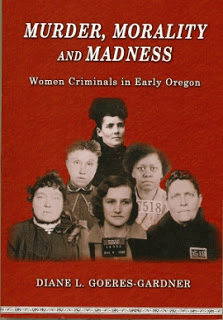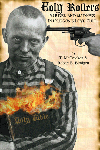A Bit of History about Oregon's Asylums and Their Patients
 An Excerpt from Diane L. Goeres-Gardner’s book
An Excerpt from Diane L. Goeres-Gardner’s book
Murder, Morality and Madness: Women Criminals in Early Oregon
($16.95, 199 pages, Distributed by Caxton Press ISBN- 978-0870044700)
Section 5
INSANITY IS THE ENEMY
Mental illness has been the cause of human violence throughout history just as it is today. In nineteenth century Oregon families and neighbors were responsible for bringing mentally ill to the attention of authorities. Psychiatric care at the community level was nonexistent so patients were routinely shipped to the nearest mental hospital.
The 1860 Oregonian published a long article detailing the various qualities in a reputable insane asylum. The lack of such a facility was equated with barbarism. “It is demanded of us by humanity, civilization, and Christianity.”
In Oregon the Hawthorne Asylum (also known as the Oregon Insane Hospital) in Portland served as Oregon’s only state supported psychiatric facility between 1862 and 1883. It was located north of Hawthorne Avenue and east of Southeast Twelfth Avenue. It provided exemplary care for patients diagnosed with everything from melancholy to paranoid mania. Dr. J. C. Hawthorne and Dr. A. M. Loryea operated it and services were provided for court ordered inmates as deemed necessary. The majority of the indigent sick were afflicted with tertiary syphilis. By 1874 the asylum received 52% of the total state budget to care for 194 patients. 1874 records indicate it cost $168,000 to house 140 men and 55 women. Thirty-two patients died in 1873 while locked in the mental asylum. Diagnoses supplied by the asylum for the inmates in 1874 were as follows:
Acute mania 39, Chronic mania 100, Epilepsy 24, Monomania 2, Melancholy 2, Dementia 25, Idiocy 14.
Oregon opened the first state operated psychiatric hospital on October 23, 1883 in Salem. At that time 372 patients were transferred from Hawthorne. 138 of them were women. The patients were transported by rail in shuttered cars and moved into the new facility during the night. By 1999 there were 526 patients and by 1898 there were 1,200.
Girls Admitted to hospital between 1882 and 1913
Records show that girls as young as age four were committed to the hospital. Between 1882 and 1913 there were 52 girls under the age of 13 sent to the Oregon State Insane Asylum (OSIA). These children were primarily diagnosed as imbeciles and idiots. Even though Fairview Hospital for the Feeble Minded was established in 1908, children continued to be sent to OSIA for five more years.
Age 4 – 1
Age 5 – 2
Age 6 – 3
Age 7 – 6
Age 8 – 5
Age 9 – 12
Age 10 – 7
Age 11 – 8
Age 12 – 8
Total 52
The oldest woman incarcerated during this time period was 91 years old and diagnosed with dementia. A random review of diagnoses revealed a wide range of psychiatric and physical illnesses. (See lists below.)
The perceived causes of insanity in women changed over the period and reflect psychiatric knowledge prevalent at the time. The Salem Statesman reported the following in 1886; “Deputy Sheriff Alexander Smith has recently brought Mrs. Emeline V. Fisher to the asylum from Grant County. Her insanity is of such a nature that she tries to starve herself.” Causes related to female anatomy were numerous.
1891 Diagnoses
reflex irritation, suppressed menses, heredity, disappointment in love, female complaint – overwork, nymphomania, religious mania, puerperal psychosis [a psychiatric disorder appearing in the first two weeks after giving birth]
1894 Diagnoses
morphine addiction, spiritualism, depravity, uterine and ovarian disease, fright, worry, melancholy, starvation, grief, domestic trouble, hysteria idiocy
1899 Diagnoses
alcohol, old age, death of family member [husband, father, mother, daughter or son], overwork and anxiety, sedentary and isolated habits, neurasthenia [a condition marked by chronic mental and physical fatigue and depression], pregnancy, change of life, weak minded, exposure, neglect and child bearing, scarlet fever, sunstroke, “her habits probably”
1904 Diagnoses
uterine trouble, sexual pervert, pelvic inflammation, childbirth, menopause, exhaustion from nursing child, religion, fast life, electrical delusion, feeble minded, grief, worry, hard work, debility and domestic trouble, ravished at 13, injury to head, opium, probably hereditary--mother insane, fast life
1910 Diagnoses
syphilis [first mention], overstudy [first mention], telepathy, mistreatment, abuse, neglect and husband’s ill treatment, overwork, weak mentally, husband leaving her, unknown [first listing]
1914 Diagnoses
idle gossip concerning Catholics, drugs, menstrual trouble, violent temper, paralytic stroke, masturbation, disappointment in love, lost means of support, hard work and childbirth, ill treatment by husband, underdeveloped female organ, operation, Christian Science delusions, love affair—led astray by man, grass widow – worry, brutal husband.
The most common diagnoses listed after 1914 were death of family member, worry, old age, overwork, malnutrition, childbirth and abortion.
Once admitted, many women stayed in the hospital until they died. The longest incarcerations were for epileptic dementia and epileptic insanity. Idiocy, dementia praecox and manic-depressives also resulted in long-term incarcerations. However, many others spent repeated amounts of time behind walls as their names occur over and over again. Paranoia diagnoses had the most repeated admittances.
From the beginning, with Charity Lamb, female convicts from the penitentiary were sent to the asylum. Sometimes it was because they were insane and sometimes it was a humanitarian gesture meant to relieve the woman’s solitary existence at the prison. At the hospital they could have company and participate in productive work. Of the twenty-three women sentenced to the prison before 1901, six were sent to the hospital. Criminals were not separated from the general population. In 1914 Helen Geren, prisoner #7101 was sent to the hospital for a year even though her admission papers clearly state she was not insane.
The two cases presented in this section illustrate the disposition of cases involving violent women who were judged to be insane. Both women focused their rage on other women. One carried out her murder attempt successfully and the other failed only by accident. Both communities were also at fault for encouraging the women’s murderous delusions.
For more information on
Murder, Morality and Madness: Women Criminals in Early Oregon
Chapter 9 of Holy Rollers: Murder & Madness in Oregon's Love Cult
(The Holy Rollers are Committed to the Insane Asylum)
Copies of Some of the Holy Rollers' Commitment Papers to the Oregon Insane Asylum
The Oregon Insane Asylum in 1907
From my Blog: My Day at The Oregon Insane Asylum
A Bit of History about Oregon's Asylums and Their Patients
An Excerpt from Diane L. Goeres-Gardner’s book
Murder, Morality and Madness: Women Criminals in Early Oregon
Newspaper Articles from 1904 about the Holy Rollers being Committed to the Insane Asylum
New York Times Article: "Once a ‘Cuckoo’s Nest,’ Now a Museum"
Steilacoom Insane Asylum
(Where Esther Mitchell Was committed in 1907)
Chapters from
Holy Rollers: Murder & Madness in Oregon's Love Cult
Part 1: The Seduction
Chapter 1: Trust Me, Brothers And Sisters
(Life Before Creffield [B.C.])
Chapter 2: God, Save Us From Compromising Preachers
(Creffield's Preachings)
Chapter 3: The Flock
(Profiles of the Holy Rollers Were)
Chapter 4: The Holy Rollers
(Things Start to Get Wild on on Kiger Island)
Chapter 5: Housecleaning
(There's a Sacrificial Bonfire)
Chapter 6: Community Concerns
(Officers Visit)
Chapter 7: Esther, The Chosen One
(Creffield Plans to Marry 16-Year- Old)
Chapter 8: Tar and Feathers
(The Men of Corvallis Act)
Chapter 9: Sane People Don’t Go Bareheaded
(Holy Rollers are Committed to the Asylum)
Chapter 10: More Beast Than Man
( Creffield is Arrested)
Chapter 11: God Will Plead Creffield's Case
(Creffield in Court)
Chapter 12: Scandal
(Shocking Testimony at the Trial)
Chapter 13: Calm Before the Storm
(The Holy Rollers Resume their Lives)
Chapter 14: Giving Up The Ghost
(Men are Gunning for Creffield)
Part Two: The People V. Creffield
Chapter 16: The Widow Creffield
Chapter 19: An Inherited Streak of Insanity
Part Three: The Madness
Chapter 23: Seeking Reconciliation
Chapter 24: Another Holy Roller Page One Murder
Chapter 25: What Can Papa Do For You?
Chapter 26: Human Life is Too Cheap In This Community
Chapter 30: The Final Chapter
(What Happened to Everyone Afterwards)
The Epilogue
(Heaven's Gate)
Information about Brainwashing & Thought Reform
Lifton's eight 'psychological themes' that can be found in totalist groups like the Holy Rollers:
***
Stanley Milgram's Obedience to Authority
***
Think You Can't be Lured into a Cult? Think Again.
The Oregon State Insane Asylum in 1907
***
Relevant Newspaper Articles:
October to December 1903: Holy Rollers Burn Furniture & Pets
April to June 1904: Holy Rollers are Committed to the Asylum
